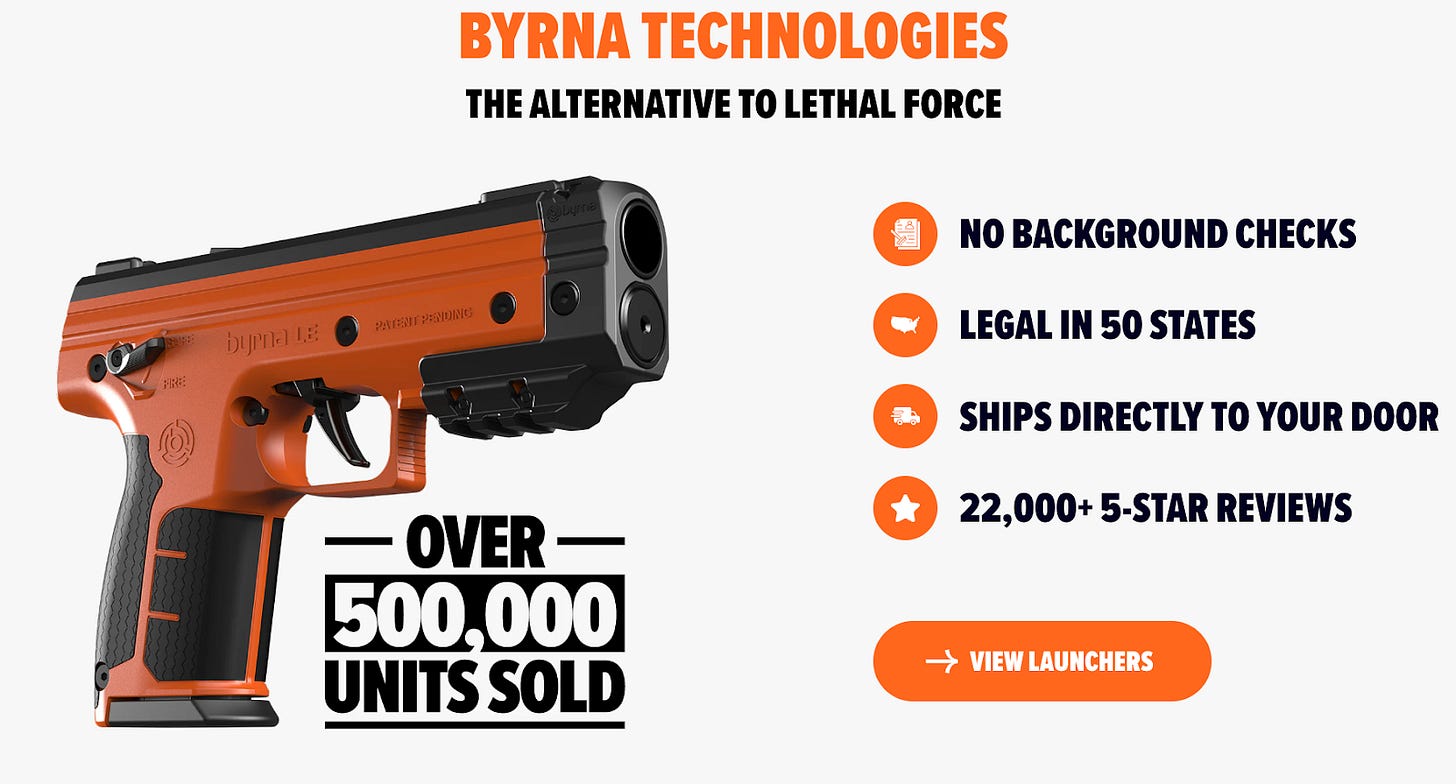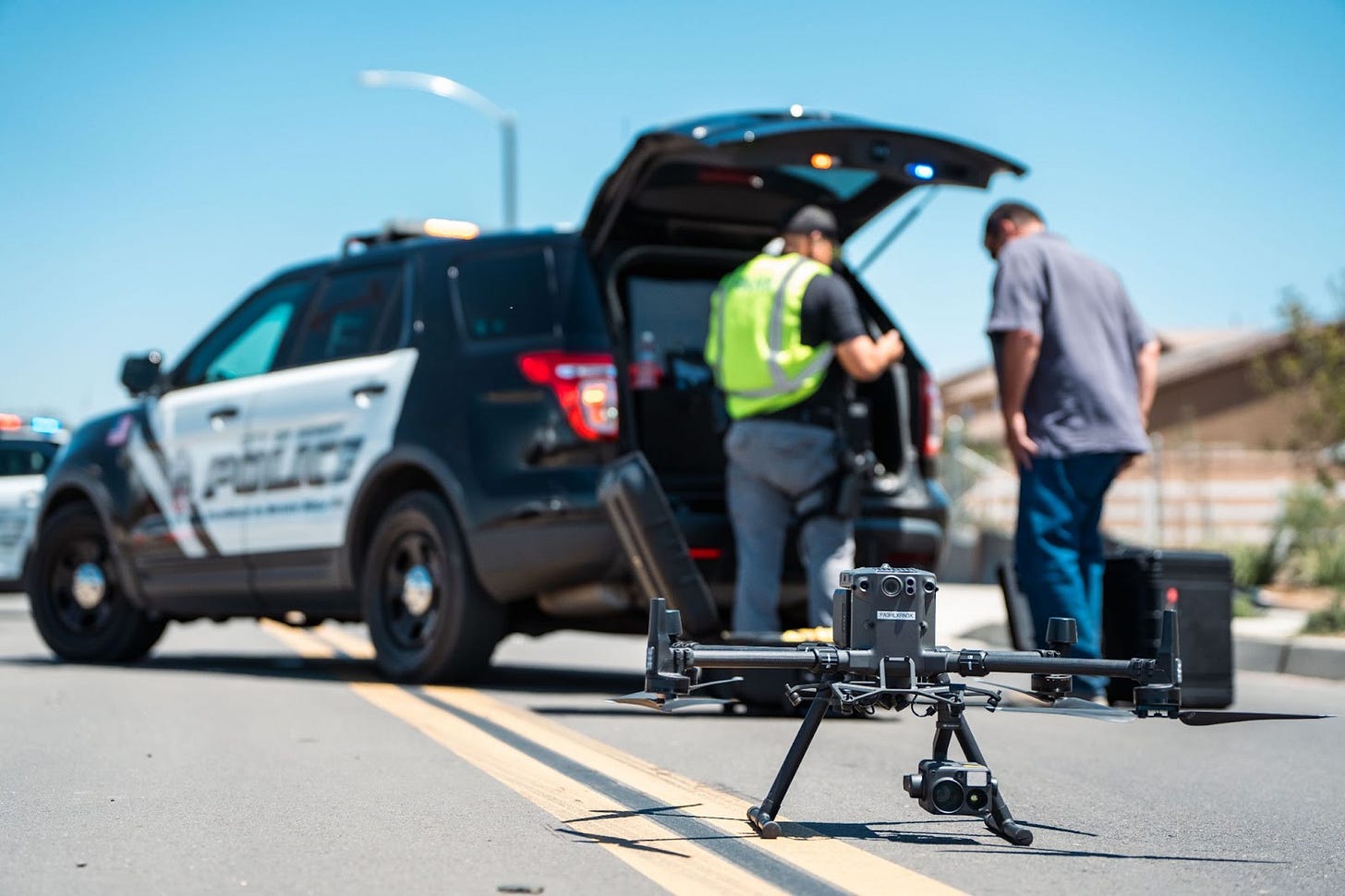On a crowded sidewalk, a shirtless man waves a machete at passers-by. He is drenched in sweat, distraught, yelling obscenities at no one in particular.
Three police officers arrive at the scene. They shout for the man to drop his weapon. Through tears, the man shouts back and charges toward the police.
At 30 feet away, the officers draw their firearms: Glock 19 semi-automatic pistols.
At 20 feet away, the man rears his machete overhead.
At 10 feet away, the police—following their training and using the tools made available to them—aim and fire approximately fifteen shots at “center mass,” i.e., the man’s chest, killing him instantly.
Later that night, the local news runs the story. Weeks later, an internal investigation determines that the police officers acted appropriately. Months later, one of the officers seeks therapy for PTSD. She is guilt-ridden yet conflicted. She tells the department psychiatrist that two images haunt her: the shirtless man's terrified eyes, and body-cam footage from training—a first-person video of a fellow officer stabbed to death after hesitating to draw his firearm.
This is the grim reality of policing in a country with, by far, the highest per capita rate of private firearm ownership, where police kill more than 1,000 people annually. How might this scenario have played out differently?
The issue is often framed as a moral or procedural dilemma—a question of the man’s decisions or the officers’ actions. But it’s also a technological problem. Police are equipped with and trained to use lethal options because truly effective less-lethal alternatives remain elusive. There is no Star Trek phaser, no dependable way to neutralize a violent threat without risking death.
But what if there were?
Let’s step back into the Tower and explore what lies ahead in the quest for less-lethal weaponry.
The Past and Present of Less-Lethal Weapons in American Policing
Historically, American policing has cycled through imperfect, occasionally brutal methods to manage disorder. Early tools—clubs and batons—often left both civilians and officers with life-altering injuries. Bringing a stick to a fist fight, a knife fight, or a gun fight proved excessive in some cases, inadequate in others.
The 20th century saw firearms become standard issue, making lethal force common even in ambiguous situations. By the 1970s, public outrage over police brutality led to a search for alternatives, spawning innovations such as rubber bullets and tear gas. These early iterations of less-lethal options proved problematic at best.
Rubber bullets might disperse an angry crowd of protestors, but their frequent misuse has resulted in dozens of deaths and thousands of severe injuries over the past thirty years. What’s more, rubber bullets are fundamentally impractical for routine police scenarios—domestic violence calls, armed robberies, carjackings—where precision and rapid incapacitation are paramount. Tear gas shares these limitations: potentially effective for crowd dispersal but regularly misapplied, often making bad situations even worse.
For everyday law enforcement encounters, three solutions have emerged: Tasers, pepper spray, and kinetic-impact projectiles.
First developed in the 1970s, Tasers work by delivering an electrical charge that temporarily disrupts voluntary muscle control. We’ve all seen the videos: the bright yellow device fires its projectiles, which (hopefully) attach to the target. Popular culture has turned Tasers and “stun guns” into punchlines; there’s the iconic scene from The Hangover where a very unarmed Zach Galifianakis takes 50,000 volts "in the face!" The reality is, uh, more complicated.
Police officers typically deploy Tasers when subjects are aggressive but unarmed. Despite their widespread use, Tasers have a mixed record of effectiveness. Axon, the manufacturer, makes often outlandish claims about Tasers’ “stopping power” and their ability to incapacitate subjects. When Tasers fail, situations can often escalate dangerously: in other words, cops panic and shoot people.
There’s an enlightening thread about Tasers on the subreddit “Ask LE [Law Enforcement].” One officer candidly shares, “I've used [my Taser] four times in nineteen years. Three of them were ineffective. I've used my fists lots of times and they've been 100% effective.”
Another adds:
No taser deployments from me in 10+ years. However, unholstering and putting those dots on the dbag and letting the dbag know what's coming next has solved a handful of problems. My favorite was a super drunk after a bar fight. Dude was easily 6'5" and 350 lbs. Drunk told us we would have to shoot him and squared to fight us. I put the taser dots on him and he immediately said " Ay ay ay let's talk about this". He almost put the handcuffs on himself lol.
That’s Tasers in a nutshell: a decent deterrent with mixed effectiveness in actual use. No one wants to "get tased," but a Taser isn't guaranteed to do the job when someone is armed and dangerous.
Pepper spray offers another non-lethal option. Again, as with Tasers, everyone is familiar with the advantages and pitfalls of this tool. Pepper spray causes temporary blindness, coughing, and intense discomfort, quickly taking the fight out of most aggressive individuals. When combined with kinetic-impact projectiles—like bean bags, sponge rounds, or foam bullets—it can effectively defuse volatile situations from a safe distance.
Kinetic rounds deliver blunt trauma, ideally causing temporary incapacitation without permanent injury. Some manufacturers are literally combining kinetic weapons with pepper-spray. Byrna, a company specializing in non-lethal self-defense products, sells to police departments and civilians alike. It’s increasingly popular as a home defense option for people uncomfortable with owning firearms. YouTube is riddled with videos of masochists demoing Byrna in their backyards, shooting themselves or their friends for views: after watching a few videos, I’m not exactly convinced that a Byrna weapon—effectively a handheld paintball gun with rounds that burst into a cloud of pepper spray—would stop a determined aggressor.
So, what else—other than a human with a gun—might stop the man with the machete without killing him or putting others’ into harm’s way?
The Future of Less-Lethal Weapons
The future of less-lethal weaponry might lie in removing human officers from the equation to some degree. Drones as first responders are emerging as a bold frontier: Skydio is a company to watch, as is Aerodome. Early trials are underway in some cities, where drones scout scenes before officers arrive, reducing the need for immediate human confrontation. For now, the use cases are purely informational: providing better situational awareness to officers before they arrive on scene.
But it’s not hard to imagine a buzzing quadcopter swooping in, armed not with bullets but with other tools to incapacitate, perhaps a Taser-like charge or a targeted burst of pepper spray. It sounds science-fictional for now—and certainly fraught with its share of legal and ethical concerns—but remember: the goal is to incapacitate only the most dangerous suspects without seriously injuring them or putting officers’ lives in danger. Drones-as-support-units, with some combat capability, seems a reasonable option and an ethical application of a technological solution: building machines that can assess and act without the split-second panic that drives lethal outcomes.
Beyond drones, robotics offers another path. Today’s prototypes—clunky, slow-moving contraptions—look more like sci-fi flops than actual solutions. But progress is inching forward. Picture the scenario I outlined earlier, except a sturdy, agile robot rolls up to the machete-wielding man, absorbing his swings while deploying a net or a stunning pulse. These machines could take the brunt of aggression, sparing both the suspect and officers from harm. They could, in effect, buy time, which law enforcement experts will tell you is the tipping point in violent encounters. For officers on the scene, when the time-distance window slams shut, they must act. A robot could stretch that window, giving space for de-escalation instead of deadly reflex. In February, the UN released a report titled “Artificial Intelligence and Robotics for Law Enforcement,” signaling that this is top of mind for the future of policing. For now, the challenge is speed and reliability; current models are often laughably inept, but engineering advances could change that in a decade or two.
Sound-based weapons could play a role here too. Devices like the Long Range Acoustic Device (LRAD) already blast excruciating noise to scatter crowds or halt threats. Let me be clear: these devices should not be used except in the most extreme situations. They can permanently damage hearing and inflict serious psychological trauma. If you haven’t seen it, check out the recent footage out of Serbia of a sound weapon being used on a crowd of protesters: it’s chilling how powerful—and effective—these devices are.
But smaller, targeted versions are being developed. Woody Norris, CEO of American Technology Corporation and an ultrasound pioneer, has created a non-lethal acoustic weapon that stops people cold in their tracks. Emitting “sonic bullets” along a narrow, 145-decibel beam, it can trigger instant migraines or knock someone to their knees, even with their ears plugged. Unlike past acoustic attempts that hit everyone nearby, Norris’ directional beam spares bystanders and operators, making it a game-changer. Police departments and the Pentagon are interested in the tech; the U.S. Army has already ordered a prototype.
These advancements suggest a broader shift toward less lethality. As for Star Trek phasers? That’s still the stuff of science fiction. In theory, law enforcement could use directed-energy devices that heat skin to unbearable levels or disrupt nerves without bloodshed. Military labs have toyed with these for years; a police-ready version might one day fit in a holster, delivering a sci-fi stun. But size, cost, and safety—avoiding fatal overheating, for example—remain hurdles. Still, the promise is tantalizing: a beam that halts a threat, leaving all parties alive.
For now, police departments should pursue a tandem approach: implementing better procedures with the tools we have now, and rigorously pursuing new technology that will lead to better outcomes. Tasers, pepper spray, and kinetic rounds aren’t perfect, but refined training—emphasizing de-escalation, precise deployment, and clear escalation thresholds—can stretch their utility. Meanwhile, the push for innovation should accelerate. We can’t erase the reality of lethal force entirely; a man with a machete at 10 feet will always demand a rapid response. But we can and should stretch our sci-fi imaginations to the limits and bring our best technological solutions to bear on a problem that is costing us too many lives.
Here’s Quest 18:
Set Phasers to Stun
Key Details
Explore your state’s gun landscape: Dive into your state’s gun laws, ownership rates, and crime stats—dig up details on concealed carry rules, open carry policies, and violent crime trends to better grasp why police act the way they do or how you’d handle a tense encounter.
Share your story in the comments: let’s have a conversation about law enforcement encounters—good and bad—using examples from your own community.
Advocate for next-gen solutions: stay informed about the latest tech, and participate in conversations on social media or at town halls about the use of less lethal weapons.










It’s been a never-ending, ever-escalating arms race since the Supreme Court ruled in 2008 the 2nd Amendment provides for individual firearm ownership vs only in connection with a well regulated militia to help preserve the security of a free state.
Given the volume of legal guns on the streets our friends in the police force probably have to assume whoever they are facing off with is packing. So they need to be better armed—cause you never know.
Of course those who mistrust the authorities (whether right or wrong) need to be better armed—cause you never know.
Wash, rinse, repeat.